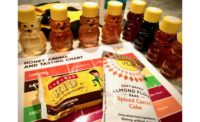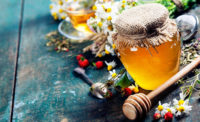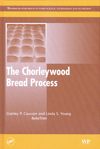Honey Editors Summit educates on honey and better-for-you products



Many products that include honey as an ingredient were sampled.
photo credit: National Honey Board

Willa's shortbread cookies
photo credit: National Honey Board

Day 1 of the Honey Editors Summit kicked off at Little Goat Kitchen, Chicago.
photo credit: National Honey Board

The honey editors summit took a tour of Goose Island Beer Company, Chicago.
photo credit: National Honey Board




Bees in their home at Patchwork Farms, Chicago.
credit: National Honey Board

Editors from various publications met up for the Honey Editors Summit. BNP Media publications represented included SFWB, Candy Industry, Prepared Foods, Dairy Foods, and Beverage Industry.
photo credit: National Honey board

The meeting room at Eli's Cheesecake, Chicago, features covers from SFWB's May 2013 issue and Dairy Foods' September 2013 issue.

The summit took a behind-the-scenes tour of Eli's Cheesecake in Chicago.
photo credit: Eli's Cheesecake (@elischeesecake)













SFWB recently got the chance to attend the Honey Editors Summit, which took place September 21-22 in Chicago. The event kicked off at the Little Goat Kitchen, where the National Honey Board gave an overview on honey and products that contain it, and later expanded to tours of a brewery, wholesaler bread business, urban apiary, and Eli’s Cheesecake.
Honey is a better choice to use in breads, snacks, and other bakery products, but a single honey bee actually only produces 1/12 of a teaspoon of honey during its lifetime. Although there are 20,000 known species of bees, only seven species of honey bees are recognized, and roughly 66% of honey consumption in the U.S. is imported, from countries like Vietnam, Argentina, India, Brazil, and Ukraine. Even rarer is organic honey; there’s only one supplier in the U.S., so when a product made with honey says it’s organic, there’s a reason it might be pricier in the grocery store than a non-organic honey product.
One of the first activities at the summit was tasting different varieties of honey—from clover honey, America’s most common single-source honey, to Northwestern Meadowfoam, which had a bit of a marshmallow flavor. Other varieties included the California Eucalyptus, known for its “medical taste,” as well as Tupelo, known as the “champagne of honey,” as it’s very rare—it’s only grown in the tip of South Carolina as well as a few places in Georgia and Florida.
Bakery products made with honey
Would you pay more for a product made with honey, rather than sugar? 54% of consumers said they’d pay more for bars made with honey, according to the National Honey Board’s segmentation study. Those who routinely purchase honey are more likely to buy “wholesome” products such as granola, yogurt, and tea, too; non-honey shoppers are more likely to purchase items like soft drinks and frozen meals, the study found.
During the summit, tastings of bakery products made with honey included offerings from companies like Dave’s Killer Bread, which prominently features the word HONEY on the label of its Honey Oats & Flax bread. Aunt Millie’s Honey & Crunchy Oat Bread promotes the crunchiness of its bread, too, and the product is promoted as a clean label bread that’s free from artificial ingredients and GMOs.
La Brea Bakery, featured in SFWB’s September cover story, is being touted for its farm-to-table bread, which is made from single-origin, heirloom grain grown in Montana.
Finding honey in the snacks and sweets aisles
From crackers to sweet goods, honey is being used across the board. Even major brands like Snyder’s-Lance are offering products made with it—its Captain’s Wafers with Peanut Butter and Honey uses honey powder (honey, wheat starch, soy lecithin) and is capitalizing on the popularity of honey spreads.
Breakfast biscuits are very popular this year too, even some that are more cookie than biscuit, and Nature Valley’s honey breakfast biscuits are made from 100% natural whole grain oats. Nabisco’s Honey Maid Dippers prominently feature the words “made with real honey” on its packaging, and prepared foods like Dr. Praeger’s Grape Sunwiches are made with honey whole wheat bread and sunflower seed butter—a good option for those who have a peanut allergy.
Innovative food bars like Regrained’s Honey Almond IPA bar are notable for using grains sourced from a local bakery, which are paired with honey, almonds, oats, and cinnamon. Curate Snacks’ Harmonious Blend Marcona Almond & Apricot lists its ingredients on the front of the package, and Kind Snacks’ Breakfast Honey Oat bar is being marketed as a breakfast bar for sustained energy all day long.
Even chocolate bars are getting in on the honey trend: Pure 7 Chocolate, with salted almonds, is made with Paleo-inspired, honey-sweetened chocolate, and its sweet and salty combination is driving sales for the company. Lake Champlain Chocolates, too, has released its Honey Caramels, which are made with Vermont honey—again, with prominent marketing of the word “honey” on the product.
Honey can be found everywhere
For the latter half of the first day of the summit, we embarked on a tour of Goose Island brewery, as well as a tasting, and a quick stop at Publican Quality Bread. There are three Publican stores/restaurants in Chicago within a one-block radius of each other: Publican Quality Bread, which is a wholesaler (the general public can’t stop by to buy bread); Publican Quality Meats (informally known as PQM), a meats and cheeses shop; and the Publican, a restaurant.
Three different breads were sampled at Publican Quality Bread, each of which contained honey, and the baker explained a bit about the baking process and how they incorporate honey into the breads.
Later that evening, a private dinner was held at Publican Quality Meats, and the Honey Board had asked PQM to try to include a dish with honey. The result was a side of tempura cauliflower, made with fresno chile, basil, honey, and riata.
Bees and cheesecake
The next day, the summit kicked off with a tour of an urban apiary, located right in Chicago. The apiary, known as Patchwork Farms, grows and sells vegetables and also has bees on-site, from which they farm honey. The farm has submitted its honey to shows before, too, and has won awards for it.
To end the summit, the National Honey Board brought us to Eli’s Cheesecake, for a tour, lunch, and a sampling of its cheesecake made with honey, which is a Mediterranean-type cheesecake. SFWB did a feature story on Eli in May 2013, and sister publication Dairy Foods did a feature in September 2013, when the Honey Almond cheesecake was first released.
Many of Eli’s products have artisan touches, as well—the tour included its entire plant, where workers add the honey and nut toppings to the cheesecake by hand. Eli’s Honey Almond cheesecake, which was the product sampled, is “wildflower honey cheesecake, enhanced with the subtle addition of ricotta, topped with a crunchy layer of salted honey, toasted pistachios and almonds, vanilla mousse, and more toasted pistachios and almonds.”
Why honey?
Honey pairs well with sweet, salty and spicy flavor profiles, which is why it’s popping up so frequently in snack foods and even bakery products. It also has a “health halo,” meaning that it’s perceived as more wholesome than sugar or processed sugars, and it’s considered clean label.
Even snacks like chips are getting in on the honey trend: Lay’s recently released Honey Butter Chips, although they aren’t available in the U.S. yet, and the internet is already raving about it. Calbee’s Honey Butter Chips, sold primarily in Korea, were previously selling on eBay for $50 per bag, and it challenged the Korean principles that snacks could only be salty or spicy.
According to a Packaged Facts online survey, 28% of consumers reported increasing their honey use over the past year or two. With honey consumption on the rise and with honey as an ingredient on the minds of more consumers nowadays, it’s a trend that will seemingly only get more popular as we soon head into 2017.
Looking for a reprint of this article?
From high-res PDFs to custom plaques, order your copy today!




















